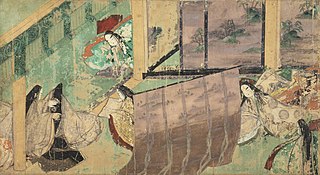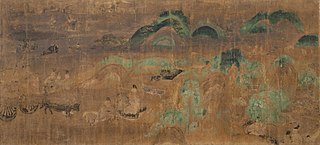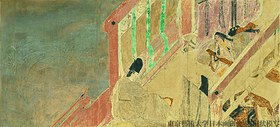307:, there is not a single full front view of a face throughout the entire scroll. There are only two different viewpoints used to show the faces. These viewpoints consist of an oblique angle of 30 degrees from the front and a right angle giving a straight profile. With the right angle the eyebrows and corners of the eyes are seen but the nose is invisible. This is a fictional depiction of a person because in actuality it is impossible to see the corner of someone's eye but not see their nose.
224:, a well known Court painter of the twelfth century. However, after continued research, this belief has been revised, and both the identity of the illustrator and the organisation of its production remain unknown. Because of the techniques used, it is obvious that various calligraphers and artists with connections to Takayoshi produced the scroll. The characteristic pictorial technique of the scroll is known as "tsukuri-e" meaning "manufactured painting", which is an extension of
353:
236:
324:
184:
292:
41:
22:
33:
314:
were not a part of everyday life and were unfamiliar to the readers. They were instead figures of one's imagination from the past or a make believe world. It was intended for the readers to portray their own image of the figures while reading the novel. If the artists had created realistic portraits
246:
is a form of painting in which the underlying paper was covered entirely with heavy pigment. There are four steps to this process. In the first step, a series of scenes with noteworthy visual effects were chosen from the respective monogatari. In the second step, the piece is executed in a black and
335:
was used for the drawing of the figure's faces, there was still a great amount of emotion that could be discerned from them. One way that the artists showed individual emotions in the figure's faces is through the placement and size of their facial features; such as the thickness of the eyebrows or
253:
as a picture scroll, the people in charge wanted to use a style that would not jar with people's image of the novel. The decided to make all the scenes peaceful, elegant and static which reflected the dominant aesthetic attitude of the artists and the early twelfth century court aristocracy towards
373:
is almost impossible to decipher. Even amongst today's most educated
Japanese people, only a few can successfully decipher it. Although it is unknown how well the Japanese people of that era could read, many believe that they, too, would have had a very difficult time. One reason given for using a
339:
For example, in chapters 37 and 39 the depiction of Lady Kumoi is of a strong-willed young woman who has become prey to overwhelming jealousy. This depiction is done by making her eyebrows a bit stronger, tiny pupils that are a little lower, eyes slightly cast down, and her upper lip being just a
138:
picture scrolls consisted of two designs: Pictures that were painted on a scroll with text added to the same scroll or a number of paintings that accompanied passages of text and were joined together in a scroll. The first known picture scroll was produced in Japan during the late ninth or tenth
343:
Another way that the artists showed emotion in the characters was by the tilt of their faces. This was done by making the characters faces look away, or covering their faces by placing them in their hands, almost completely covering them, or showing them looking away. The artists also portrayed
247:
white drawing. Pigments were added to the basic drawing and the details are colored in the third step. In the last step, the original black lines, which are now covered by paint, were drawn back in with ink in order to make the picture stand out more. When deciding to represent the novel
288:("blown-off roof") refers to a form of composition that gives a bird's eye view of the interior of a building, with the roof and ceiling not shown. In some cases, interior partitions are omitted. The artists were very realistic with the architectural details of the scroll.
368:
styles that consisted of delicate flowing lines and others with definite brush strokes. The purpose of this style of calligraphy was more for aesthetic enjoyment of the design rather than for reading. Because of this style of calligraphy, the
191:
The original scroll was about 450 feet long. It consisted of twenty rolls, contained over 100 paintings, and had over 300 sheets of calligraphy. The surviving scrolls of The Genji
Monogatari Emaki, however, are not a complete depiction of
151:
scroll but it is also the oldest surviving non-Buddhist scroll in Japan. There is no exact date to the scroll, but it is estimated to being sometime between 1120 and 1140, in which case it was created just a little over a century after
315:
of the figures it would have interfered with the images that the readers had. Therefore, the artist chose to use the unrealistic technique of hikime kagibana so that the readers individual image of the figures could be preserved.
344:
individual expressions and emotions to the characters by using inanimate elements. Some examples that were used throughout the scroll were autumn grasses and raindrops. The autumn grasses were used as a symbol of human emotion.
92:. The surviving sections, now broken up and mounted for conservation reasons, represent only a small portion of the original work (if it was complete) and are now divided between two museums in Japan,
112:, arguably up to the present day. The painted images in the scroll show a tradition and distinctive conventions that are already well developed, and may well have been several centuries in the making.
310:
Although the illustration of architecture throughout the scroll is very realistic, the images of the faces are very unrealistic. This is said to be because the dominant figures in the novel
402:
commentary, have allowed scholars to identify extant manuscripts that seem to preserve a pre-Teika form of the text. The best known of these is the Yomei-bunko Genji.
221:
232:
as the process of applying paint to a black and white drawing. It also referred to the painter himself, as opposed to the artist who did the basic drawing.
228:. The tsukuri-e style was hardly ever used by male painters but was almost always used by female paintings. This style is referred to in the actual novel
171:
comes from
Japanese art forms. The purpose of the construction of the scroll was to provide a visual depiction, and further explanation, of the novel
416:
666:
881:
639:
602:
563:
891:
689:
629:
382:
The textual fragments found in the scrolls are notable in that they preserve the oldest known form of the text of the
800:
659:
299:
Hikime kagibana style described the illustration of people with faces drawn with essentially identical features:
581:
784:
792:
303:. This technique takes place in all but one of the nineteen pictures in the scroll. Also characteristic of
167:
scroll differs in almost all values and art styles of the
Chinese which leads to the assumption that the
101:
652:
860:
765:
749:
594:
374:
writing style so difficult to read is that legibility would have taken away from the visual effect.
855:
833:
757:
364:
scroll did not use just one style of calligraphy but many different styles. For example, they used
644:
196:. It consists of only 19 paintings, 65 sheets of text, and 9 pages of fragments housed in the
640:
https://web.archive.org/web/20071018212210/http://www.geocities.com/sljohnson1980/genji1.htm
572:
Paine, Robert Treat, in: Paine, R. T. & Soper A., "The Art and
Architecture of Japan",
100:, where they are only briefly exhibited, again for conservation reasons. Both groups are
8:
197:
93:
72:
26:
104:. It is the earliest surviving text of the work and the earliest surviving work in the
886:
548:
717:
680:
598:
577:
559:
391:
256:
249:
143:
picture scroll, however, was produced in the early twelfth century. Not only is the
77:
826:
819:
675:
336:
lips, the angle of the eyebrows or eyes, and the space between the eyes and brows.
153:
633:
588:
280:
727:
702:
274:
722:
626:
875:
707:
411:
212:. The surviving scroll amounts to about 15 percent of the original scroll.
205:
109:
97:
82:
108:
tradition of narrative illustrated scrolls, which has continued to impact
712:
555:
352:
235:
187:
A scene of
Kashiwagi. All paintings were produced by "tsukuri-e" process.
323:
183:
365:
291:
148:
68:
40:
590:
Envisioning the Tale of Genji: =media, gender, and cultural production
327:
A scene from the "Minori" chapter depicting the death of Lady
Murasaki
21:
697:
220:
Until relatively recently, the scroll was believed to be the work of
127:
32:
243:
105:
732:
674:
484:
488:
201:
36:
Landscape scene from the "Seki-ya" chapter, Tokugawa Art Museum
209:
638:
Stylistic appeal of genji monogatari emaki. Retrieved from
386:
This text is different in many respects from the standard
318:
576:, 3rd ed 1981, Penguin (now Yale History of Art),
547:
873:
456:
454:
452:
417:List of National Treasures of Japan (paintings)
295:A scene of Yadorigi in "hikime kagibana" style.
272:is characterized by two pictorial techniques:
133:
125:
56:
660:
449:
517:
505:
493:
25:A scene of Azumaya from the scroll owned by
627:http://www.dartmouth.edu/~arth17/Genji.html
466:
437:
667:
653:
398:as well as in the Genji shaku, the first
44:The "sawarabi" scene, Tokugawa Art Museum
545:
523:
511:
499:
460:
351:
322:
290:
234:
182:
39:
31:
20:
586:
472:
443:
874:
538:Morris, I. & Tokugawa, Y. (1971).
263:
648:
542:. Japan: Kodansha International LTD.
239:Scene from the "yadorigi gi" chapter
319:Emotional aspects of the characters
16:12th-century illustrated handscroll
13:
132:" meaning "picture scrolls". The
14:
903:
882:Works based on The Tale of Genji
801:Genji Monogatari: Sennen no Nazo
67:Scroll, is a famous illustrated
554:. Arts of Japan. Vol. 5.
478:
428:
347:
134:
126:
1:
422:
178:
86:
793:Sennen no Koi Story of Genji
7:
892:National Treasures of Japan
405:
102:National Treasures of Japan
10:
908:
532:
331:Although the technique of
115:
861:Nise Murasaki Inaka Genji
843:
811:
776:
766:Genji Monogatari Sennenki
741:
688:
595:Columbia University Press
550:Narrative picture scrolls
394:. The text found in the
215:
57:
856:The Tale of Genji Museum
546:Okudaira, Hideo (1973).
540:The Tale of Genji Scroll
587:Shirane, Haruo (2008).
377:
301:slit eyes and hook nose
851:Genji Monogatari Emaki
574:Pelican History of Art
371:Genji Monogatari Emaki
357:
328:
296:
270:Genji Monogatari Emaki
240:
188:
169:Genji Monogatari Emaki
165:Genji Monogatari Emaki
145:Genji Monogatari Emaki
81:, produced during the
51:Genji Monogatari Emaki
45:
37:
29:
390:text associated with
355:
326:
294:
238:
222:Fujiwara no Takayoshi
186:
147:the oldest surviving
124:stems from the word "
43:
35:
24:
264:Pictorial technique
198:Tokugawa Art Museum
94:Tokugawa Art Museum
73:Japanese literature
27:Tokugawa Art Museum
632:2010-02-24 at the
625:). Retrieved from
358:
329:
297:
241:
189:
46:
38:
30:
869:
868:
785:The Tale of Genji
750:The Tale of Genji
718:Kiritsubo Consort
681:The Tale of Genji
604:978-0-231-14237-3
565:978-0-8348-2710-3
392:Fujiwara no Teika
362:The Tale of Genji
312:The Tale of Genji
257:The Tale of Genji
250:The Tale of Genji
230:The Tale of Genji
194:The Tale of Genji
173:The Tale of Genji
158:The Tale of Genji
78:The Tale of Genji
65:The Tale of Genji
899:
834:Genji monogatari
758:Genji Monogatari
676:Murasaki Shikibu
669:
662:
655:
646:
645:
619:Genji monogatari
614:
612:
611:
569:
553:
527:
526:, pp. 70–71
521:
515:
514:, pp. 60–61
509:
503:
502:, pp. 49–53
497:
491:
482:
476:
475:, pp. 66–68
470:
464:
458:
447:
441:
435:
432:
340:little thicker.
154:Murasaki Shikibu
141:Genji Monogatari
137:
136:
131:
130:
91:
90: 1120–1140
88:
62:
60:
59:
907:
906:
902:
901:
900:
898:
897:
896:
872:
871:
870:
865:
839:
807:
772:
737:
684:
673:
634:Wayback Machine
609:
607:
605:
566:
535:
530:
522:
518:
510:
506:
498:
494:
483:
479:
471:
467:
459:
450:
442:
438:
433:
429:
425:
408:
380:
360:The artists of
350:
333:hikime kagibana
321:
305:Hikime Kagibana
281:hikime kagibana
266:
218:
181:
118:
89:
54:
17:
12:
11:
5:
905:
895:
894:
889:
884:
867:
866:
864:
863:
858:
853:
847:
845:
841:
840:
838:
837:
830:
823:
815:
813:
809:
808:
806:
805:
797:
789:
780:
778:
774:
773:
771:
770:
762:
754:
745:
743:
739:
738:
736:
735:
730:
728:Murasaki no Ue
725:
720:
715:
710:
705:
703:Lady Fujitsubo
700:
694:
692:
686:
685:
672:
671:
664:
657:
649:
643:
642:
636:
615:
603:
584:
570:
564:
543:
534:
531:
529:
528:
516:
504:
492:
477:
465:
448:
436:
434:Paine, 133–134
426:
424:
421:
420:
419:
414:
407:
404:
379:
376:
349:
346:
320:
317:
286:Fukinuki yatai
275:fukinuki yatai
265:
262:
217:
214:
180:
177:
117:
114:
63:, also called
15:
9:
6:
4:
3:
2:
904:
893:
890:
888:
885:
883:
880:
879:
877:
862:
859:
857:
854:
852:
849:
848:
846:
842:
836:
835:
831:
829:
828:
824:
822:
821:
817:
816:
814:
810:
803:
802:
798:
795:
794:
790:
787:
786:
782:
781:
779:
775:
768:
767:
763:
760:
759:
755:
752:
751:
747:
746:
744:
740:
734:
731:
729:
726:
724:
721:
719:
716:
714:
711:
709:
706:
704:
701:
699:
696:
695:
693:
691:
687:
683:
682:
677:
670:
665:
663:
658:
656:
651:
650:
647:
641:
637:
635:
631:
628:
624:
623:Tale of Genji
620:
616:
606:
600:
596:
592:
591:
585:
583:
579:
575:
571:
567:
561:
557:
552:
551:
544:
541:
537:
536:
525:
524:Okudaira 1973
520:
513:
512:Okudaira 1973
508:
501:
500:Okudaira 1973
496:
490:
486:
481:
474:
469:
463:, p. 109
462:
461:Okudaira 1973
457:
455:
453:
445:
440:
431:
427:
418:
415:
413:
410:
409:
403:
401:
397:
393:
389:
385:
375:
372:
367:
363:
354:
345:
341:
337:
334:
325:
316:
313:
308:
306:
302:
293:
289:
287:
283:
282:
277:
276:
271:
261:
259:
258:
252:
251:
245:
237:
233:
231:
227:
223:
213:
211:
207:
203:
199:
195:
185:
176:
174:
170:
166:
161:
159:
155:
150:
146:
142:
139:century. The
129:
123:
113:
111:
107:
103:
99:
95:
84:
80:
79:
74:
70:
66:
53:
52:
42:
34:
28:
23:
19:
850:
832:
825:
818:
799:
791:
783:
764:
756:
748:
708:Hikaru Genji
679:
622:
618:
608:. Retrieved
589:
573:
549:
539:
519:
507:
495:
480:
473:Shirane 2008
468:
446:, p. 50
444:Shirane 2008
439:
430:
412:Gotoh Museum
399:
395:
387:
383:
381:
370:
361:
359:
342:
338:
332:
330:
311:
309:
304:
300:
298:
285:
279:
273:
269:
267:
255:
248:
242:
229:
225:
219:
206:Gotoh Museum
193:
190:
172:
168:
164:
162:
157:
144:
140:
121:
119:
110:Japanese art
98:Gotoh Museum
83:12th century
76:
64:
50:
49:
47:
18:
742:Anime/manga
723:Lady Rokujō
713:Kaoru Genji
556:Weatherhill
356:Calligraphy
348:Calligraphy
876:Categories
690:Characters
610:2011-04-12
582:0140561080
423:References
179:Dimensions
149:monogatari
85:, perhaps
69:handscroll
887:Emakimono
827:The Diver
820:Aoi no Ue
761:(c. 1989)
698:Aoi no Ue
485:Tsukuri-e
135:emakimono
128:emakimono
120:The word
630:Archived
617:(2000).
406:See also
388:Aobyōshi
244:Yamato-e
226:yamato-e
204:and the
106:Yamato-e
96:and the
75:classic
733:Ukifune
533:Sources
116:History
71:of the
804:(2011)
796:(2001)
788:(1951)
769:(2009)
753:(1979)
601:
580:
562:
489:JAANUS
384:Genji.
366:marker
216:Design
202:Nagoya
156:wrote
58:源氏物語絵巻
844:Other
812:Stage
777:Films
400:Genji
396:emaki
210:Tokyo
122:emaki
599:ISBN
578:ISBN
560:ISBN
378:Text
278:and
268:The
163:The
48:The
678:'s
208:in
200:in
878::
597:.
593:.
558:.
487:,
451:^
284:.
260:.
175:.
160:.
87:c.
668:e
661:t
654:v
621:(
613:.
568:.
61:)
55:(
Text is available under the Creative Commons Attribution-ShareAlike License. Additional terms may apply.






